
The Formicinae are a subfamily within the Formicidae containing ants of moderate evolutionary development.

Trophobiosis is a symbiotic association between organisms where food is obtained or provided. The provider of food in the association is referred to as a trophobiont. The name is derived from the Ancient Greek τροφή (trophē), meaning "nourishment", and -βίωσις (-biosis), which is short for the English word symbiosis.

Acropyga is a genus of small formicine ants. Some species can be indirect pests. A. acutiventris, which is found from India to Australia, tends subterranean, root-feeding mealybugs of the species Xenococcus annandalei. Living, gravid females are carried in the jaws of A. acutiventris queens during their nuptial flight, to establish the symbiotic association in founding colonies. Other Acropyga species have relationships with different species of mealybugs, and it could be a trait common to the whole genus.

The tawny crazy ant or Rasberry crazy ant, Nylanderia fulva, is an ant originating in South America. Like the longhorn crazy ant, this species is called "crazy ant" because of its quick, unpredictable movements. It is sometimes called the "Rasberry crazy ant" in Texas after the exterminator Tom Rasberry, who noticed that the ants were increasing in numbers in 2002. Scientists have reorganised the genera taxonomy within this clade of ants, and now it is identified as Nylanderia fulva.
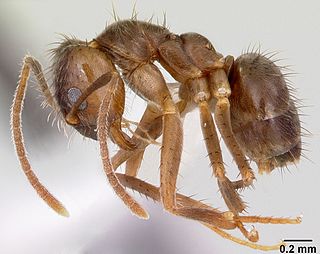
Nylanderia pubens is a species of ant of the genus Nylanderia, commonly called the Caribbean crazy ant. It was originally described as Paratrechina pubens from Saint Vincent, Lesser Antilles. This species was moved from Paratrechina to the genus Nylanderia in 2010.

The longhorn crazy ant, also known as "black crazy ant", is a species of small, dark-coloured insect in the family Formicidae. These ants are commonly called "crazy ants" because instead of following straight lines, they dash around erratically. They have a broad distribution, including much of the tropics and subtropics, and are also found in buildings in more temperate regions, making them one of the most widespread ant species in the world. This species, as well as all others in the ant subfamily Formicinae, cannot sting. However, this species can fire/shoot a formic acid spray from its abdomen when under attack by other insects or attacking other insects. When the longhorn crazy ant bends its abdomen while aiming at an enemy insect, it is most likely shooting its hard-to-see acid. This acid is normally not used on humans and normally does not affect humans. The black crazy ant can not harm humans in any way. These ants can be touched safely just like the common ghost ants.

Euprenolepis is a Southeast Asian genus of ants in the subfamily Formicinae with eight recognized species.

Nylanderia is a large genus of ants in the subfamily Formicinae. The genus has a nearly cosmopolitan distribution with species inhabiting a wide array of habitats in almost all geographic regions. Nylanderia, currently containing over 110 species, is an ecologically important genus, with some species reported as being invasive. The ants are small to medium in size and range in color from pale yellow to black.

Paraparatrechina is a genus of small ants in the subfamily Formicinae. The genus contains 31 species distributed in the tropics of Africa, Asia and Australia.
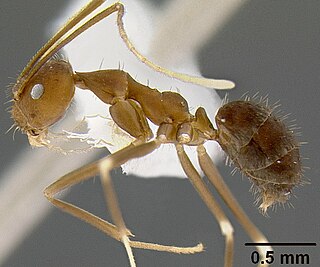
Zatania is a genus of ants in the subfamily Formicinae. The genus is known from Central America and the Greater Antilles.
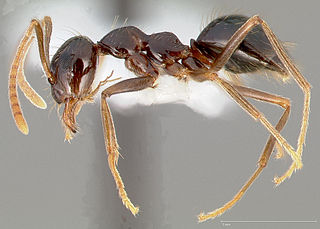
Prenolepis is a genus of ants in the subfamily Formicinae. Most species are found in southeastern Asia and southern China, but the genus has a wide distribution with species known from North America, southern Europe, Anatolia, Cuba, Haiti, and West Africa.
Myrmecophilus americanus is an ant cricket, a wingless cricket that is an obligate parasite of ants and lives in their nests.

Vitsika is a Malagasy genus of ants in the subfamily Myrmicinae. Described in 2014, the genus contains 14 species.
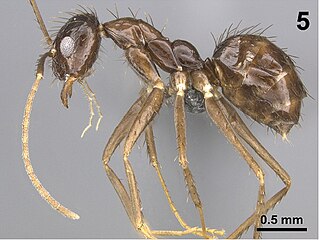
Paratrechina zanjensis is an African species of ant in the genus Paratrechina. It is one of two species in the genus, the other being the longhorn crazy ant.
This list of fossil arthropods described in 2009 is a list of new taxa of trilobites, fossil insects, crustaceans, arachnids and other fossil arthropods that have been described during the year 2009, as well as other significant discoveries and events related to arthropod paleontology that occurred.
Macrodinychus multispinosus is a mite that lives as an ectoparasitoid on the invasive Paratrechina longicornis. These mites complete their development on a single host, sucking all of its body content and therefore killing it. This is the ninth species of Macrodinychus reported as ant parasite, and the third known as parasitoid of invasive ants, confirming a unique habit in the evolution of mite feeding strategies and suggesting that the entire genus might be parasitic on ants.

Nylanderia pygmaea is an extinct species of formicid in the ant subfamily Formicinae known from fossils found in the Baltic region.
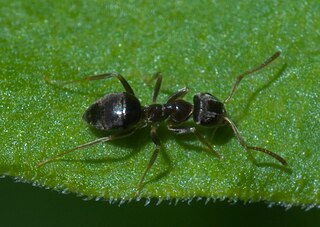
Lasiini is a tribe of ants in the family Formicidae. There are about 10 genera and more than 450 described species in Lasiini.
In ecology, a tramp species is an organism that has been spread globally by human activities. The term was coined by William Morton Wheeler in the bulletin of the American museum of natural history in 1906, used to describe ants that “have made their way as well known tramps or stow-aways[sic] to many islands The term has since widened to include non-ant organisms, but remains most popular in myrmecology. Tramp species have been noted in multiple phyla spanning both animal and plant kingdoms, including but not limited to arthropods, mollusca, bryophytes, and pteridophytes. The term "tramp species" was popularized and given a more set definition by Luc Passera in his chapter of David F William's 1994 book Exotic Ants: Biology, Impact, And Control Of Introduced Species.















